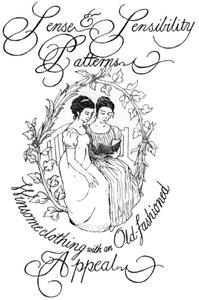"How do I line a sheer Regency dress?"
I get a lot of great questions from customers, and I usually just answer via email. However, when I get a question several times, I know it's time to turn it into a Tip post! So, without further ado, here is today's question:
Hi, I just wanted to ask your opinion about the Elegant Lady’s Closet pattern drawstring dress. I’ve made your dress several times, and I’ve enjoyed doing so. I’d like to create a gown out of cotton lawn, which is quite see through. I was thinking of adding a full lining to the inside of the gown bodice and omitting the stays lining. Do you think this would work? I usually omit your stays lining, as I don’t wear my gown with them (just modern bra), but I’ve only done this with fabric that is not so sheer. Also, would it also be possible to add an inner lining to the skirt? Thank you! I don’t really know how to go about adding lining, so thought I’d ask before hacking my fabric up. ~ Kim
Fantastic question, Kim! The method you are looking for is called "flat lining," and it is a period-correct technique to boot. It's also a great way to stabilize a more delicate fabric (like lightweight silk). If you use a conventional lining, all of your bodice seams will show through your sheer fabric, so that's why you want to use flat lining instead. I recommend using pima cotton, as it is lightweight and soft and won't make your layers too stiff for the drawstring.
The Bodice
After you have cut your dress pieces from your sheer material, lay the out the bodice and skirt pieces on your lining fabric and cut a new set (there is really no need to line the sleeves unless you do not want them to be sheer...and sheer sleeves are a rather beautiful thing, in my opinion!). To use the bodice pieces as your flat lining, you will place the wrong side of the lining on the wrong side of each bodice piece and baste them together around their outer edges. This makes each one into a double-thick piece. Below is a photo from my Romantic Era Dress pattern instructions, showing the lining laid over top of the bodice back pieces and pinned around the outer edges to flat line each piece:
Once you've finished all the basting, pin and sew all the flat-lined bodice pieces together just as shown in the instructions, including any seam finishes you wish to use. For the drawstring dress, make the neckline casing as shown, then pin it to the outside of the bodice neckline, right sides together. Stitch through both layers and finish as directed. When you turn the casing to the inside of the neckline, you still need to make sure you fold it under and top-stitch it through both layers so that the dress looks right when the drawstring is pulled. If you stitch the casing only to the lining on the inside of the bodice, the outer (sheer) fabric will not pull up correctly, as it won't be stitched to the casing. That's kind of hard to illustrate, but it's much easier to do, I promise! In the photo below, you see me hand-stitching the neckline casing to my drawstring gown. Having hand stitches show on the outside of your gown is perfectly kosher. I have seen some extant gowns with the most incredibly sloppy stitches, but they vanish from sight when you step back a foot. Don't feel like you have to be machine-perfect to make it right.
The Skirt
For the skirt, there is no need to flat line, as the lining will act like a petticoat and can hang free on its own. Sew the skirt front and back together and set aside, then sew the lining pieces together, pressing all seams to finish (I recommend using a French seam for the sheer dress material). Now baste the lining to the skirt around the upper edge before sewing both layers to the bodice and making the waistline casing as shown in the pattern's instructions.When you try on your dress, you can have a helper mark the hems for you, and you'll want to make sure the skirt lining and skirt hem are even or that the lining's hem is just slightly shorter than the skirt (so it doesn't show beneath the skirt's hem). Hem skirt and lining separately and iron neatly.That's all there is to it! Don't hesitate to drop a line if you have any further questions. I am happy to help!


